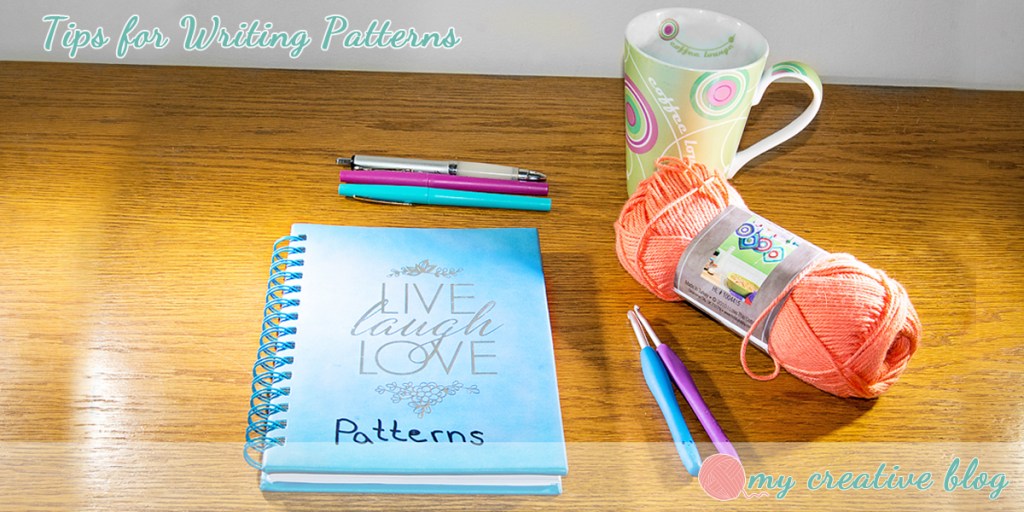I have compiled a list of tips to keep in mind when writing a pattern. I hope they can help in your own pattern writing, as I use many of them when writing my own patterns.
- Indicate Regional Terminology
- Such as whether your crochet terms are written in American Standard or British Standard Terms. Different regions differ by terminology and stitch names. For example, the stitch Americans know as single crochet Brits call double crochet. This is why we must be sure to be very clear about which convention we use. Because the internet includes so many people from different regions, every pattern published online (whether for free or for a fee) must include a note about which regional convention is used. This will allow your crocheter to convert the terms if needed, and save them from having a frustrating time if they assume it’s written in crochet terms they are familiar with when it is not.
- Include an Abbreviations Legend
- Abbreviating stitch names and common words are standard in crochet patterns. This saves on space and is actually clearer to write than writing crochet over and over as it’s in most stitch names. Just be consistent throughout your pattern and to help with that, create a legend, so people don’t have to go look up that particular abbreviation. This is particularly helpful for beginners.
- Special Stitches Definitons
- For common stitches, you can get away with just listing them and their abbreviation in a legend. Most people know and understand a single crochet, a double crochet, a half double crochet, but for those less common and more difficult stitches, it is best to include a definition of how the stitch is worked. I like to not only write out the definition of the stitch but also include a photo of the stitch and a link to a tutorial that better explains how the stitch is created. This saves the crocheter from having to go look it up themselves.
- Instructions for the Pattern
- This is the area where you can include information about how your pattern is written and read and how the project is constructed. For instance, anything between ** indicates repeating, anything between [] means working in the same stitch, is the item worked in the round without turning, and any other important things to note.
- List your Material
- List all the tools and materials the crocheter will need to complete the project. Include the yarn weight, type, and the amount in yards. If you’d prefer to write how many skeins you used, be sure to include the exact brand name of the yarn used. A reference to yarn weights can be found at Craft Yarn Council. Include the hook size, in metric, used in the pattern. Alphabetic and non-metric number sizes used in the U.S. and elsewhere are not standard from manufacturer to manufacturer or region to region, which means that there can be variation between the actual sizes of hooks bearing the same designation. The metric size of a hook, given in millimeters, is not a variable. List any other items the crocheter will need to finish the project, such as buttons, zippers, stuffing, etc. Indicate how many and sizes of the items needed.
- Include your Gauge
- Gauge information is crucial to include. Even if you don’t think the exact finished size of your design is important, you must include information about gauge. This will give your crocheter the ability to make the item the same exact size as the one in the pattern, if they adjust, based on their tension, to match the gauge given. As a crocheter, the only way to ensure that your project is the same size as the designer’s is to make a gauge swatch before you start and adjust accordingly.
- Include Measurements
- List all relevant dimensions of the finished project, including the final measured size of the item.
If your design is written for different sizes, include the finished measurements for every size. It can be beneficial to include the measurements for individual pieces if the item needs to be assembled. - Difficulty Level
- It’s a good idea to include the difficulty level of the pattern so that the crocheter knows if their level of experience is adequate enough to tactical the pattern. It can be troubling to determine the level of difficulty of your pattern. If your pattern uses lots of special stitches and techniques, it’s safe to say it is more suited for an advanced crocheter. If your pattern uses simple stitches and is well instructed, it could be categorized as a beginner pattern. Obviously, a pattern of beginner level can reach a much larger base of crocheters than one of an advanced nature. It is often best to take note of how your pattern testers feel while testing your pattern to help gauge the difficulty of your pattern. A good reference to the different skill levels can be found at Craft Yarn Council.
- Stitch Count
- Provide the total stitch count at the end of every row or round. Sometimes it can be beneficial, when doing different stitches in the same row or round, to indicate the exact number of each stitch. This is a quick way to help your crocheter determine if they made a mistake if their count does not match the count given for the row or round.
- Grouping Instructions
- Square brackets, parentheses, and asterisks are used to group instructions within a row or a round of a pattern. Be consistent in the way you use these; do not use them interchangeably! For example, instructions inside brackets can indicate working in the same stitch and instructions between asterisks can indicate instructions that need to be repeated. However you use them, it’s just important to be consistent and make sure your crocheter knows how they are being used.
- Photos
- It is very important and necessary to have a photo of your finished product, at the very least. It is also good to have ones illustrating tough to understand techniques and your progress. If showcasing attachment of pieces, very unique stitches, or hard to understand techniques, it can be very beneficial to have one to several photos showing how to do it. If your pattern calls for making separate pieces, it can be very helpful to also show a final photo of this finished piece. This will help your crocheter to compare their progress against the progress of the pattern.
- Placement for Part Attachment
- When attaching pieces of an item or embroidering features on an item, it can be very helpful to indicate the round or row and stitch count of the placement. This is especially helpful when joining motifs or embroidering on features in amigurumi such as the face.
- Diagrams and Charts
- Charts and diagrams can be helpful in patterns where something visual might demonstrate the stitch or placement better than words. They can also be very helpful in illustrating where pieces are joined. A list of chart symbols and their meaning can be found at Craft Yarn Council.
- Testers and Proofreaders
- Always have testers and proofreaders for your patterns, especially if you plan on selling them. You may think you have written the perfect pattern, but having a second set of eyes can help you find any mistakes you may have made or help to make things clearer that could be interpreted in another way. It will also help you to gauge the difficulty level of your pattern or find ways to make it easier to understand. And for anything written, it’s always ideal to have someone proofread your work. I know with autocorrect, it is always trying to change my abbreviations for crochet terms, and I don’t always catch it.
- Tips
- Don’t get fancy, don’t include special techniques you do as the main part of the pattern. You found a neat way to make a clean turn or decrease, make it a suggestion or tip outside of the pattern instructions. When writing a pattern, it’s best to stick to standard ways of doing things. That’s not to say you can’t make mention of this cool technique you use, but make it as a side note, so the crocheter knows it’s optional and doesn’t get hung up on it if they can’t do it.
- Print Friendly Version
- I’m very much a digital person, so I never gave this idea any thought, but it can be great for anyone who wants to print out the pattern without wasting a bunch of ink. In this version, limit the images to only the very essential, or cut them out entirely. This will be a separate version of your pattern, so they can always refer back to the normal version to reference pictures. Keep the font color black for very easy printing. Consider grayscale for anything that might otherwise have color. Without images in the way, you may be able to format the pattern differently, such as using columns and cut down on the number of pages it spans across.
These are all tips I have picked up along the way. Do you have anything else to add that would be a great tip for pattern writers? Leave your comment below to share with everyone.
Bonus:
A great site to sell your pattern on is Ravelry. It’s a vast network of people looking specifically for patterns. They have a wonderful platform in which to do it, as well. Ravelry does charge a small percentage of your sales to use it, but it is well worth it for the tools they give you in which to sell your pattern. Check out these links I have gathered below to get started:
Getting Started as Pattern Designer on Ravelry
Starting a Pattern Store on Ravelry
Ravelry Shopkeeper Fees
Another great site is Craftsy. They don’t have a full platform quite like Ravelry to sell on, but they don’t charge you anything to sell on it. Unfortunately, it’s still in the growing stage, so there isn’t as much traffic to it for patterns. But it’s worth putting your pattern on it, since it is no cost to you, and you never know who might stumble across it.
You can also sell digital patterns on Etsy, too. They’ve come a long way with digital products from where they used to be, but they can be quite costly to sell on. Right off the bat, they charge you $0.20 just for listing your pattern whether you sell it or not. But like Craftsy, it can be another avenue for people to stumble across your pattern on. Don’t plan on a lot of traffic from this site either as it is very saturated and of course, isn’t just for selling patterns.


Leave a comment